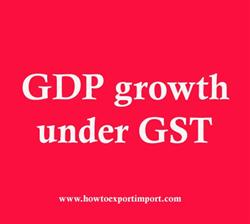GDP growth Means
The details about GDP growth are explained here.
GDP Growth:
The Goods and Services Tax (GST), the landmark tax reform to be implemented from 1 July, would help raise India GDP growth rate to above 8%, the International Monetary Fund (IMF) has said, but expressed concern over the Rs7 trillion in bad loans in the Indian banking system.
 Observing that India is the “fastest growing emerging market economy” in the region, Tao Zhang, deputy managing director of the International Monetary Fund, said the IMF believes that India will continue to grow at a fast pace, with a projected 6.8% rate for financial year 2016-17 and 7.2% in 2017-18.
Observing that India is the “fastest growing emerging market economy” in the region, Tao Zhang, deputy managing director of the International Monetary Fund, said the IMF believes that India will continue to grow at a fast pace, with a projected 6.8% rate for financial year 2016-17 and 7.2% in 2017-18.
The government has made significant progress on important economic reforms that will support strong and sustainable growth going forward and expect that the GST, which is targeted to be applied, starting in July, will help raise India’s medium-term growth to above 8%, as it will enhance production and the movement of goods and services across Indian states.
“The currency exchange initiative led to a slowdown in economic activity. However, there are initial signs of recovery as the currency exchange has been progressing well,” Zhang, who assumed the role of deputy managing director at the IMF in August, last year, said on demonetisation.
Zhang, who worked at the World Bank from 1995 to 1997 and at the Asian Development Bank from 1997 to 2004, said a key concern for the IMF in India is the health of the banking system which is still dealing with a large amount of “bad loans” as well as “heightened corporate vulnerabilities” in several key sectors of the economy.
In India, bad loans of public banks rose by over Rs1 lakh crore to Rs6.06 lakh crore during April-December of 2016-17, the bulk of which came from power, steel, road infrastructure and textiles sectors. The gross bad loans stood at Rs5,02,068 crore at the end of 2015-16. Zhang also stressed on the need for labour market reforms in India.
“As India persists with its strong reform efforts, labour market reforms should take priority,” he noted. These would facilitate greater and better quality jobs, raise female labour force participation and enhance the impact of recent product market reforms, he observed. “While there has been important progress generally, we see scope to pursue better targeting and greater efficiency of subsidy and social spending programmes through greater use of the trio of Aadhaar unique beneficiary identification, direct benefit transfers and information technology,” Zhang said.
GST will increase govt. revenue in the long term due to higher tax compliance, good GDP growth:
The Goods and Services Tax (GST) will increase the government's revenue in the long term, than in the short term, as tax compliance increases and GDP growth is bolstered.
“The unified national system should offer significant opportunities for productivity,” Fitch stated. “For example, it will become much quicker and less costly to move goods across the country now that trucks will not be held up at checkpoints at State borders. Smoother logistics should reduce retailers' need for working capital and allow them to operate centralised warehouses, rather than in every State.
“The new electronic filing system is also likely to lead to more tax reporting,” the report said. “Moreover, the tax base will be broadened, as only SMEs [small and medium enterprises] with sales of Rs 2 million ($31,000) will now be exempt from paying the GST, down from Rs 15 million. Small informal retailers - which account for over 90% of retail sales - should also find it harder to understate their sales or to avoid filing tax returns altogether in a system where transactions are tracked throughout the supply chain. This could accelerate the shift toward organised retail.”
The report noted that the informal sector is very large, accounting for over 20% of the GDP and 80% of employment, and is largely untaxed. This is one of the reasons why government revenue is low, at just 21.4% of the GDP in 2016, compared with a median of 29.9% for 'BBB' range sovereigns.
This post describes about GDP growth. Comment below your thoughts about this post GDP growth.
Learn Exports Imports Free, Click here
Click here to know GST rate of your goods or service
Section 67 of CGST Act, 2017 Power of inspection, search and seizure
Section 20 of IGST Act,2017 Application of provisions
Tax wrongfully collected and paid to Central Government or State Government, IGST Act,2017
Zero rated supply, section 16 of IGST Act,2017
section 14 of IGST Act,2017, Special provision for payment of tax by a supplier
Section 59 of CGST Act, 2017 Self-assessment
Consumer Welfare Fund, Section 57 of CGST Act, 2017
Refund of tax, Sec 54 of CGST Act, 2017
Transfer of input tax credit, Section 53 of CGST Act, 2017
Tax deduction at source, Sec 51 of CGST Act, 2017
Interest on delayed payment of tax, Section 50 of CGST Act, 2017
Power to grant exemption from tax under section 6 of IGST Act,2017
Input Service Distributor under GST
Meaning of term Inward supply under GST
What is GST Invoice Format and Rules
How to upload documents in e Sanchit
Quantitative restrictions
The Federation of Indian Export Organisations FIEO
Hub and Spoke network
Define transportation management system (TMS)
Inventory Management
Transloading VS Crossdocking
Documents required for Export from Bolivia
Customs procedures for Bolivia Export
Registration required to export from Bolivia